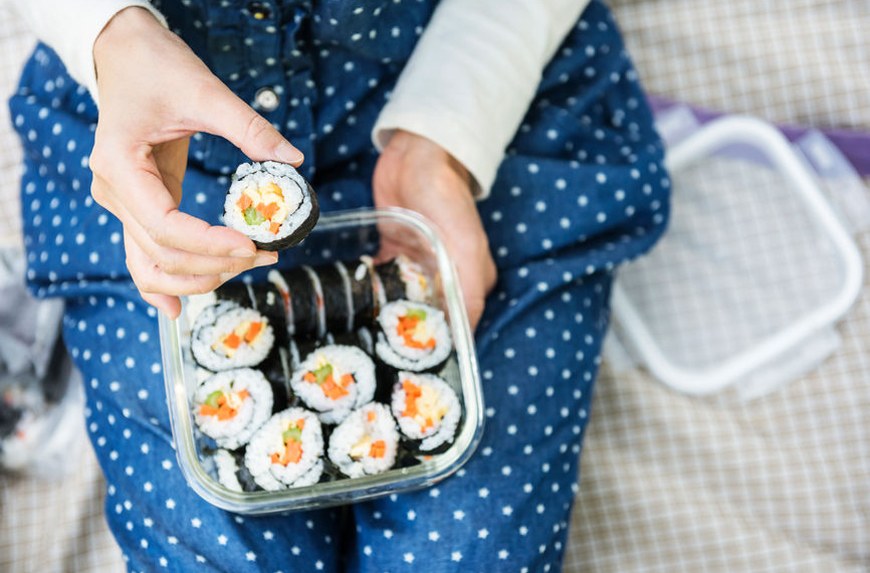Whether they're from the prepped food sections of grocery stores to restaurant-plated rolls, nutrition labels aren’t often pasted onto your sushi-selection. So I reached out to experts for tips on how to make sure your sushi roll is actually healthy.
Keep reading for four tips on how to keep your sushi habit healthy.

1. Fish, but make it quality
In addition to starring nutrients like vitamin D, heart-healthy omega-3s, selenium, seafood has also been linked to better sleep and turn up the heat in the bedroom (wink)... not to mention is packed with protein. But the average American only eats a third of the recommended eight ounces of seafood per week, according to the United States Department of Agriculture. For fish-eaters, sushi is a great way to up your seafood intake.
But the key to a healthy roll is really fresh fish. “You do need to be careful of the quality of the fish that you’re eating,” says Bonnie Taub-Dix, RDN, author of Read It Before You Eat It. Ariana Lutzi Ph.D, co-founder of Paix Medicine in Santa Fe, California and nutrition consultant for BUBS Naturals recommends talking to your server to find out where the fish is from, and when and how it was caught. “Wild caught is generally healthier for you and has a higher concentration of omega-3 fatty acids. While farm raised tends to have high concentrations of toxins and byproducts.” Yep, she’s talking about mercury.

{{post.sponsorText}}
The general consensus is that the fear of mercury is slightly over-hyped—one study found that seafood accounted for only seven percent of the mercury in women's bodies. There are more fish that are low in mercury than high in mercury— see this list of low-mercury fish from the Food and Drug Administration to see the full range of options. If you eat sushi on the reg, keep in mind that higher-mercury fish include shark, swordfish, king mackerel, tilefish, big-eye tuna, and yellowfin.
2. Roll it up right
Typically, you’ll have the option of wrapping your roll with white or brown rice. Taub-Dix recommends brown, which comes out ahead of white in terms of fiber and protein, and can be helpful if you find rice constipating. “Just be aware that some restaurants add glucose or sugar molecules to brown rice to make it stickier, so ask if the rice has any additives,” suggests Lutzi. White may have has less sodium and more calcium and iron than brown. The takeaway: you really can’t go wrong.
“One roll is about equivalent to a slice of bread, and is about one-third cup of rice, which may be a helpful conversion if you’re watching portion size or counting carbs,” says Taub-Dix.
If you’re not super hungry, see if the restaurant offers veggie substitutes. “Sometimes you may get the option to have the roll wrapped in cucumbers," says Dr. Lutzi.

3. Add avocado
Avocados are a popular sushi roll ingredient, especially for vegans and vegetarians. So it's easy to get your healthy fats and magnesium with your order. Plus, their fat content will help you feel full faster and for longer, says Taub Dix, so you don't have to eat three or four to satisfy your stomach.
4. Cut down on condiments
Dips and sauces can seriously spike the sodium and sugar content of this otherwise healthy meal. Case in point: just one tablespoon of a reduced-sodium variety can contain 575 mg of sodium—25 percent of the recommended limit. And one tablespoon of eel sauce has 335 mg of sodium, 7 grams of sugar, and 32 calories.
Spicy mayo, too, is also not-so-healthy. “Spicy mayo is still mayo so it has a similarly high concentration of fat,”says Taub-Dix—one tablespoon contains eight grams of fat which is 13 percent of recommended daily intake. “I advise against consuming too spicy mayo. But it has a kick because of the spicy sauce, so most people naturally won’t use too too much,” says Taub-Dix. If you find yourself going heavy on the mayo specifically for the kick, Dr. Lutzi recommends using wasabi instead.
Some condiments, on the other hand, fall on the good-for-you end of the spectrum. “Pickled ginger and lemon are packed for of flavor and are good for your gut,” says Dr. Lutzi. Ponzu—which is made with rice vinegar, citrus juice, soy sauce, kelp, bonito flakes, and mirin— is also a decently healthy option.
So, is sushi healthy?
Ultimately, when made with the above tips in mind, sushi rolls bring some serious health-perks up to the table. To name a few pros:
- The seaweed-wrap is uber-nutritious.
- The fish—cooked or raw—packs a protein punch.
- The veggies stuffed inside are full of fiber, antioxidants, and vitamins.
- Toppings like ginger and lemon are good for your gut.
- The rice has a place in a well-balanced eating plan.
As mentioned above, certain toppings and sauces detract from those benefits. Consider these cons:
- Anytime the roll includes something that is fried, like crunchy flakes or tempura fried shrimp, it adds extra saturated fat.
- Most of the sauces—soy sauce, spicy mayo, eel sauce, and teriyaki—are high in sodium and sugar.
- The rice may be mixed with unhealthy additives like sugar.
The bottomline is that, “the way you order it and the way the roll is going to be is the determine factor in just how healthy your roll is,” says Dr. Lutzi. But the “best” roll choice really depends on what your personal nutritional needs are.
If you’re looking for more actually healthy-eats to incorporate into your life, try amaranth or tahini. And if you love eating your food all rolled up, try making this banana almond-butter sushi recipe.
Loading More Posts...